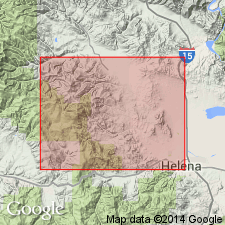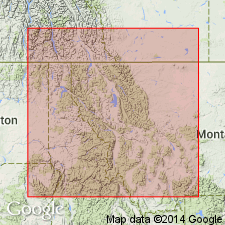
- Usage in publication:
-
- Greenhorn Mountain quartzite
- Modifications:
-
- Named
- Dominant lithology:
-
- Quartzite
- AAPG geologic province:
-
- Northern Rocky Mountain region
Summary:
Name applied to a newly recognized formation of the Belt series that is younger than Marsh Formation (formerly Marsh shale), also of the Belt. Separated from Flathead quartzite by an erosion surface. Top of Marsh deep maroon, ripple marked, mud cracked argillite with interbedded thin quartzite. This new formation is a feldspathic quartzite, 1,800 ft thick. The lower part is massive quartzite showing festoon cross-lamination. Upper third is well stratified in beds 1 to 2 inches thick. In previous mapping has been included with undifferentiated Devonian and Cambrian rocks. Makes up the bulk of Greenhorn Mountain and surrounding areas on the Continental Divide between Mullan Pass and Marysville, Lewis and Clark Co., MT in the Northern rocky Mountain region. No type locality designated.
Source: GNU records (USGS DDS-6; Denver GNULEX).

- Usage in publication:
-
- Greenhorn Mountain Quartzite†
- Modifications:
-
- Abandoned
Summary:
Abandoned in favor of Bonner Quartzite. Was used formerly in the Northern Rocky Mountain region as a formation in the Belt Supergroup.
Source: GNU records (USGS DDS-6; Denver GNULEX).
For more information, please contact Nancy Stamm, Geologic Names Committee Secretary.
Asterisk (*) indicates published by U.S. Geological Survey authors.
"No current usage" (†) implies that a name has been abandoned or has fallen into disuse. Former usage and, if known, replacement name given in parentheses ( ).
Slash (/) indicates name conflicts with nomenclatural guidelines (CSN, 1933; ACSN, 1961, 1970; NACSN, 1983, 2005, 2021). May be explained within brackets ([ ]).

